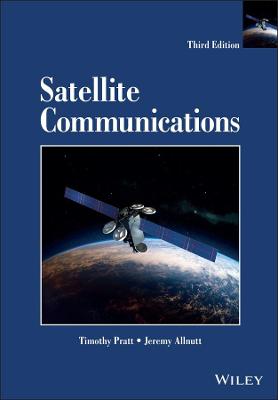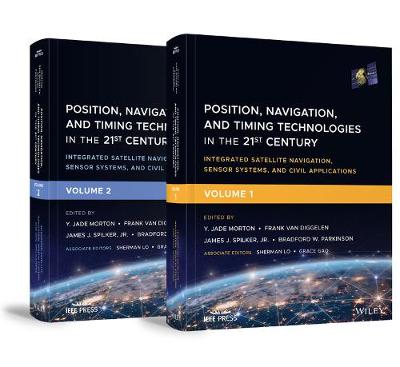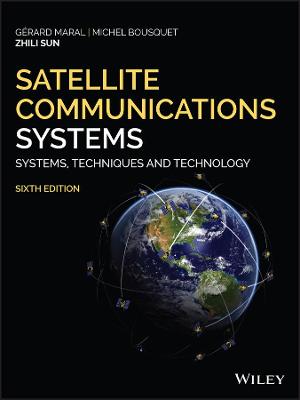Satellite Communications
 -15%
portes grátis
-15%
portes grátis
Satellite Communications
Pratt, Timothy; Allnutt, Jeremy E.
John Wiley & Sons Inc
12/2019
768
Dura
Inglês
9781119482178
15 a 20 dias
1596
Descrição não disponível.
Preface xi
About the Authors xv
1 Introduction 1
1.1 Background 1
1.2 A Brief History of Satellite Communications 5
1.3 Satellite Communications in 2018 9
1.4 Overview of Satellite Communications 11
1.5 Summary 14
1.6 Organization of This Book 15
References 16
2 Orbital Mechanics and Launchers 17
2.1 Introduction 17
2.2 Achieving a Stable Orbit 17
2.3 Kepler's Three Laws of Planetary Motion 23
2.4 Describing the Orbit of a Satellite 25
2.5 Locating the Satellite in the Orbit 27
2.6 Locating the Satellite with Respect to the Earth 29
2.7 Orbital Elements 31
2.8 Look Angle Determination 33
2.9 Orbital Perturbations 42
2.10 Orbit Determination 46
2.11 Space Launch Vehicles and Rockets 47
2.12 Placing Satellites Into Geostationary Orbit 56
2.13 Orbital Effects in Communications Systems Performance 59
2.14 Manned Space Vehicles 62
2.15 Summary 64
Exercises 65
References 68
3 Satellites 71
3.1 Satellite Subsystems 72
3.2 Attitude and Orbit Control System (AOCS) 75
3.3 Telemetry, Tracking, Command, and Monitoring (TTC&M) 84
3.4 Power Systems 88
3.5 Communications Subsystems 90
3.6 Satellite Antennas 100
3.7 Equipment Reliability and Space Qualification 107
3.8 Summary 113
Exercises 114
References 116
4 Satellite Link Design 119
4.1 Introduction 119
4.2 Transmission Theory 125
4.3 System Noise Temperature and G/T Ratio 130
4.4 Design of Downlinks 142
4.5 Ku-Band GEO Satellite Systems 149
4.6 Uplink Design 158
4.7 Design for Specified CNR: Combining CNR and C/I Values in Satellite Links 163
4.8 System Design for Specific Performance 167
4.9 Summary 188
Exercises 189
References 193
5 Digital Transmission and Error Control 195
5.1 Digital Transmission 197
5.2 Implementing Zero ISI Transmission in the Time Domain 215
5.3 Probability of Error in Digital Transmission 221
5.4 Digital Transmission of Analog Signals 231
5.5 Time Division Multiplexing 241
5.6 Packets, Frames, and Protocols 243
5.7 Error Control 246
5.8 Summary 264
Exercises 266
References 269
6 Modulation and Multiple Access 271
6.1 Introduction 271
6.2 Digital Modulation 273
6.3 Multiple Access 287
6.4 Frequency Division Multiple Access (FDMA) 291
6.5 Time Division Multiple Access (TDMA) 308
6.6 Synchronization in TDMA Networks 317
6.7 Transmitter Power in TDMA Networks 319
6.8 Star and Mesh Networks 323
6.9 Onboard Processing 324
6.10 Demand Assignment Multiple Access (DAMA) 329
6.11 Random Access (RA) 333
6.12 Packet Radio Systems and Protocols 334
6.13 Code Division Multiple Access (CDMA) 337
6.14 Summary 348
Exercises 349
References 352
7 Propagation Effects and Their Impact on Satellite-Earth Links 355
7.1 Introduction 355
7.2 Propagation Phenomena 358
7.3 Quantifying Attenuation and Depolarization 359
7.4 Propagation Effects That are Not Associated with Hydrometeors 367
7.5 Rain and Ice Effects 372
7.6 Prediction of Rain Attenuation 380
7.7 Prediction of XPD 390
7.8 Propagation Impairment Countermeasures 399
7.9 Summary 404
Exercises 405
References 408
8 Low Throughput Systems and Small Satellites 411
8.1 Introduction 411
8.2 Small Satellites 413
8.3 Operational Use of SmallSats 436
8.4 Low Throughput Mobile Communications Satellite Systems 440
8.5 VSAT Systems 444
8.6 Signal Formats 461
8.7 System Aspects 469
8.8 Time Over Coverage 470
8.9 Orbital Debris 471
8.10 Summary 472
Exercises 473
References 475
9 NGSO Satellite Systems 481
9.1 Introduction 481
9.2 Orbit Considerations 485
9.3 Coverage and Frequency Considerations 501
9.4 System Considerations 523
9.5 Operational and Proposed NGSO Constellation Designs 526
9.6 System Design Example 534
9.7 Summary 535
Exercises 537
References 539
10 Direct Broadcast Satellite Television and Radio 543
10.1 C-Band and Ku-Band Home Satellite TV 545
10.2 Digital DBS-TV 545
10.3 DVB-S and DVB-S2 Standards 556
10.4 DBS-TV System Design 569
10.5 DBS-TV Link Budget for DVB-S and DVB-S2 Receivers 572
10.6 Second Generation DBS-TV Satellite Systems Using DVB-S2 Signal Format 575
10.7 Master Control Station and Uplink 576
10.8 Installation of DBS-TV Antennas 577
10.9 Satellite Radio Broadcasting 578
10.10 Summary 583
Exercises 584
References 586
11 Satellite Internet 589
11.1 History of Satellite Internet Access 589
11.2 Geostationary Satellite Internet Access 592
11.3 NGSO Satellite Systems 604
11.4 Link Budgets for NGSO Systems 613
11.5 Packets and Protocols for NGSO Systems 618
11.6 Gateways, User Terminals, and Onboard Processing Satellites 622
11.7 Total Capacity of OneWeb and SpaceX Proposed NGSO Constellations 625
11.8 End of Life Disposal of NGSO Satellites 625
11.9 Comparison of Spot Beam Coverage of GSO and LEO Internet Access Satellites 626
11.10 User Terminal Antennas for Ku-Band, Ka-Band, and V-Band 627
11.11 Summary 628
Exercises 629
References 629
12 Satellite Navigation and the Global Positioning System 633
12.1 The Global Positioning System 634
12.2 Radio and Satellite Navigation 637
12.3 GPS Position Location Principles 640
12.4 GPS Codes and Frequencies 644
12.5 Satellite Signal Acquisition 648
12.6 GPS Signal Levels 658
12.7 GPS Navigation Message 662
12.8 GPS C/A Code Standard Positioning System Accuracy 663
12.9 Differential GPS 667
12.10 Denial of Service: Jamming and Spoofing 669
12.11 ADS-B and Air Traffic Control 672
12.12 GPS Modernization 673
12.13 Summary 675
Exercises 676
References 677
Glossary 681
Appendix A Decibels in Communications Engineering 691
Appendix B Antennas 695
Appendix C Complementary Error Function erfc(x) and Q FunctionQ(z) 715
Appendix D Digital Transmission of Analog Signals 719
Index 731
About the Authors xv
1 Introduction 1
1.1 Background 1
1.2 A Brief History of Satellite Communications 5
1.3 Satellite Communications in 2018 9
1.4 Overview of Satellite Communications 11
1.5 Summary 14
1.6 Organization of This Book 15
References 16
2 Orbital Mechanics and Launchers 17
2.1 Introduction 17
2.2 Achieving a Stable Orbit 17
2.3 Kepler's Three Laws of Planetary Motion 23
2.4 Describing the Orbit of a Satellite 25
2.5 Locating the Satellite in the Orbit 27
2.6 Locating the Satellite with Respect to the Earth 29
2.7 Orbital Elements 31
2.8 Look Angle Determination 33
2.9 Orbital Perturbations 42
2.10 Orbit Determination 46
2.11 Space Launch Vehicles and Rockets 47
2.12 Placing Satellites Into Geostationary Orbit 56
2.13 Orbital Effects in Communications Systems Performance 59
2.14 Manned Space Vehicles 62
2.15 Summary 64
Exercises 65
References 68
3 Satellites 71
3.1 Satellite Subsystems 72
3.2 Attitude and Orbit Control System (AOCS) 75
3.3 Telemetry, Tracking, Command, and Monitoring (TTC&M) 84
3.4 Power Systems 88
3.5 Communications Subsystems 90
3.6 Satellite Antennas 100
3.7 Equipment Reliability and Space Qualification 107
3.8 Summary 113
Exercises 114
References 116
4 Satellite Link Design 119
4.1 Introduction 119
4.2 Transmission Theory 125
4.3 System Noise Temperature and G/T Ratio 130
4.4 Design of Downlinks 142
4.5 Ku-Band GEO Satellite Systems 149
4.6 Uplink Design 158
4.7 Design for Specified CNR: Combining CNR and C/I Values in Satellite Links 163
4.8 System Design for Specific Performance 167
4.9 Summary 188
Exercises 189
References 193
5 Digital Transmission and Error Control 195
5.1 Digital Transmission 197
5.2 Implementing Zero ISI Transmission in the Time Domain 215
5.3 Probability of Error in Digital Transmission 221
5.4 Digital Transmission of Analog Signals 231
5.5 Time Division Multiplexing 241
5.6 Packets, Frames, and Protocols 243
5.7 Error Control 246
5.8 Summary 264
Exercises 266
References 269
6 Modulation and Multiple Access 271
6.1 Introduction 271
6.2 Digital Modulation 273
6.3 Multiple Access 287
6.4 Frequency Division Multiple Access (FDMA) 291
6.5 Time Division Multiple Access (TDMA) 308
6.6 Synchronization in TDMA Networks 317
6.7 Transmitter Power in TDMA Networks 319
6.8 Star and Mesh Networks 323
6.9 Onboard Processing 324
6.10 Demand Assignment Multiple Access (DAMA) 329
6.11 Random Access (RA) 333
6.12 Packet Radio Systems and Protocols 334
6.13 Code Division Multiple Access (CDMA) 337
6.14 Summary 348
Exercises 349
References 352
7 Propagation Effects and Their Impact on Satellite-Earth Links 355
7.1 Introduction 355
7.2 Propagation Phenomena 358
7.3 Quantifying Attenuation and Depolarization 359
7.4 Propagation Effects That are Not Associated with Hydrometeors 367
7.5 Rain and Ice Effects 372
7.6 Prediction of Rain Attenuation 380
7.7 Prediction of XPD 390
7.8 Propagation Impairment Countermeasures 399
7.9 Summary 404
Exercises 405
References 408
8 Low Throughput Systems and Small Satellites 411
8.1 Introduction 411
8.2 Small Satellites 413
8.3 Operational Use of SmallSats 436
8.4 Low Throughput Mobile Communications Satellite Systems 440
8.5 VSAT Systems 444
8.6 Signal Formats 461
8.7 System Aspects 469
8.8 Time Over Coverage 470
8.9 Orbital Debris 471
8.10 Summary 472
Exercises 473
References 475
9 NGSO Satellite Systems 481
9.1 Introduction 481
9.2 Orbit Considerations 485
9.3 Coverage and Frequency Considerations 501
9.4 System Considerations 523
9.5 Operational and Proposed NGSO Constellation Designs 526
9.6 System Design Example 534
9.7 Summary 535
Exercises 537
References 539
10 Direct Broadcast Satellite Television and Radio 543
10.1 C-Band and Ku-Band Home Satellite TV 545
10.2 Digital DBS-TV 545
10.3 DVB-S and DVB-S2 Standards 556
10.4 DBS-TV System Design 569
10.5 DBS-TV Link Budget for DVB-S and DVB-S2 Receivers 572
10.6 Second Generation DBS-TV Satellite Systems Using DVB-S2 Signal Format 575
10.7 Master Control Station and Uplink 576
10.8 Installation of DBS-TV Antennas 577
10.9 Satellite Radio Broadcasting 578
10.10 Summary 583
Exercises 584
References 586
11 Satellite Internet 589
11.1 History of Satellite Internet Access 589
11.2 Geostationary Satellite Internet Access 592
11.3 NGSO Satellite Systems 604
11.4 Link Budgets for NGSO Systems 613
11.5 Packets and Protocols for NGSO Systems 618
11.6 Gateways, User Terminals, and Onboard Processing Satellites 622
11.7 Total Capacity of OneWeb and SpaceX Proposed NGSO Constellations 625
11.8 End of Life Disposal of NGSO Satellites 625
11.9 Comparison of Spot Beam Coverage of GSO and LEO Internet Access Satellites 626
11.10 User Terminal Antennas for Ku-Band, Ka-Band, and V-Band 627
11.11 Summary 628
Exercises 629
References 629
12 Satellite Navigation and the Global Positioning System 633
12.1 The Global Positioning System 634
12.2 Radio and Satellite Navigation 637
12.3 GPS Position Location Principles 640
12.4 GPS Codes and Frequencies 644
12.5 Satellite Signal Acquisition 648
12.6 GPS Signal Levels 658
12.7 GPS Navigation Message 662
12.8 GPS C/A Code Standard Positioning System Accuracy 663
12.9 Differential GPS 667
12.10 Denial of Service: Jamming and Spoofing 669
12.11 ADS-B and Air Traffic Control 672
12.12 GPS Modernization 673
12.13 Summary 675
Exercises 676
References 677
Glossary 681
Appendix A Decibels in Communications Engineering 691
Appendix B Antennas 695
Appendix C Complementary Error Function erfc(x) and Q FunctionQ(z) 715
Appendix D Digital Transmission of Analog Signals 719
Index 731
Este título pertence ao(s) assunto(s) indicados(s). Para ver outros títulos clique no assunto desejado.
<p>satellite communication; satellite communication textbook; satcom applications; satcom reference; satcom systems; satcom systems textbook; satcom 101; orbital mechanics and launchers; geostationary satellites; non-geostationary and low earth orbit satellite systems; satellite Internet access; DVB-S1; DVB-S2; GPS; Global satellite navigation systems</p>
Preface xi
About the Authors xv
1 Introduction 1
1.1 Background 1
1.2 A Brief History of Satellite Communications 5
1.3 Satellite Communications in 2018 9
1.4 Overview of Satellite Communications 11
1.5 Summary 14
1.6 Organization of This Book 15
References 16
2 Orbital Mechanics and Launchers 17
2.1 Introduction 17
2.2 Achieving a Stable Orbit 17
2.3 Kepler's Three Laws of Planetary Motion 23
2.4 Describing the Orbit of a Satellite 25
2.5 Locating the Satellite in the Orbit 27
2.6 Locating the Satellite with Respect to the Earth 29
2.7 Orbital Elements 31
2.8 Look Angle Determination 33
2.9 Orbital Perturbations 42
2.10 Orbit Determination 46
2.11 Space Launch Vehicles and Rockets 47
2.12 Placing Satellites Into Geostationary Orbit 56
2.13 Orbital Effects in Communications Systems Performance 59
2.14 Manned Space Vehicles 62
2.15 Summary 64
Exercises 65
References 68
3 Satellites 71
3.1 Satellite Subsystems 72
3.2 Attitude and Orbit Control System (AOCS) 75
3.3 Telemetry, Tracking, Command, and Monitoring (TTC&M) 84
3.4 Power Systems 88
3.5 Communications Subsystems 90
3.6 Satellite Antennas 100
3.7 Equipment Reliability and Space Qualification 107
3.8 Summary 113
Exercises 114
References 116
4 Satellite Link Design 119
4.1 Introduction 119
4.2 Transmission Theory 125
4.3 System Noise Temperature and G/T Ratio 130
4.4 Design of Downlinks 142
4.5 Ku-Band GEO Satellite Systems 149
4.6 Uplink Design 158
4.7 Design for Specified CNR: Combining CNR and C/I Values in Satellite Links 163
4.8 System Design for Specific Performance 167
4.9 Summary 188
Exercises 189
References 193
5 Digital Transmission and Error Control 195
5.1 Digital Transmission 197
5.2 Implementing Zero ISI Transmission in the Time Domain 215
5.3 Probability of Error in Digital Transmission 221
5.4 Digital Transmission of Analog Signals 231
5.5 Time Division Multiplexing 241
5.6 Packets, Frames, and Protocols 243
5.7 Error Control 246
5.8 Summary 264
Exercises 266
References 269
6 Modulation and Multiple Access 271
6.1 Introduction 271
6.2 Digital Modulation 273
6.3 Multiple Access 287
6.4 Frequency Division Multiple Access (FDMA) 291
6.5 Time Division Multiple Access (TDMA) 308
6.6 Synchronization in TDMA Networks 317
6.7 Transmitter Power in TDMA Networks 319
6.8 Star and Mesh Networks 323
6.9 Onboard Processing 324
6.10 Demand Assignment Multiple Access (DAMA) 329
6.11 Random Access (RA) 333
6.12 Packet Radio Systems and Protocols 334
6.13 Code Division Multiple Access (CDMA) 337
6.14 Summary 348
Exercises 349
References 352
7 Propagation Effects and Their Impact on Satellite-Earth Links 355
7.1 Introduction 355
7.2 Propagation Phenomena 358
7.3 Quantifying Attenuation and Depolarization 359
7.4 Propagation Effects That are Not Associated with Hydrometeors 367
7.5 Rain and Ice Effects 372
7.6 Prediction of Rain Attenuation 380
7.7 Prediction of XPD 390
7.8 Propagation Impairment Countermeasures 399
7.9 Summary 404
Exercises 405
References 408
8 Low Throughput Systems and Small Satellites 411
8.1 Introduction 411
8.2 Small Satellites 413
8.3 Operational Use of SmallSats 436
8.4 Low Throughput Mobile Communications Satellite Systems 440
8.5 VSAT Systems 444
8.6 Signal Formats 461
8.7 System Aspects 469
8.8 Time Over Coverage 470
8.9 Orbital Debris 471
8.10 Summary 472
Exercises 473
References 475
9 NGSO Satellite Systems 481
9.1 Introduction 481
9.2 Orbit Considerations 485
9.3 Coverage and Frequency Considerations 501
9.4 System Considerations 523
9.5 Operational and Proposed NGSO Constellation Designs 526
9.6 System Design Example 534
9.7 Summary 535
Exercises 537
References 539
10 Direct Broadcast Satellite Television and Radio 543
10.1 C-Band and Ku-Band Home Satellite TV 545
10.2 Digital DBS-TV 545
10.3 DVB-S and DVB-S2 Standards 556
10.4 DBS-TV System Design 569
10.5 DBS-TV Link Budget for DVB-S and DVB-S2 Receivers 572
10.6 Second Generation DBS-TV Satellite Systems Using DVB-S2 Signal Format 575
10.7 Master Control Station and Uplink 576
10.8 Installation of DBS-TV Antennas 577
10.9 Satellite Radio Broadcasting 578
10.10 Summary 583
Exercises 584
References 586
11 Satellite Internet 589
11.1 History of Satellite Internet Access 589
11.2 Geostationary Satellite Internet Access 592
11.3 NGSO Satellite Systems 604
11.4 Link Budgets for NGSO Systems 613
11.5 Packets and Protocols for NGSO Systems 618
11.6 Gateways, User Terminals, and Onboard Processing Satellites 622
11.7 Total Capacity of OneWeb and SpaceX Proposed NGSO Constellations 625
11.8 End of Life Disposal of NGSO Satellites 625
11.9 Comparison of Spot Beam Coverage of GSO and LEO Internet Access Satellites 626
11.10 User Terminal Antennas for Ku-Band, Ka-Band, and V-Band 627
11.11 Summary 628
Exercises 629
References 629
12 Satellite Navigation and the Global Positioning System 633
12.1 The Global Positioning System 634
12.2 Radio and Satellite Navigation 637
12.3 GPS Position Location Principles 640
12.4 GPS Codes and Frequencies 644
12.5 Satellite Signal Acquisition 648
12.6 GPS Signal Levels 658
12.7 GPS Navigation Message 662
12.8 GPS C/A Code Standard Positioning System Accuracy 663
12.9 Differential GPS 667
12.10 Denial of Service: Jamming and Spoofing 669
12.11 ADS-B and Air Traffic Control 672
12.12 GPS Modernization 673
12.13 Summary 675
Exercises 676
References 677
Glossary 681
Appendix A Decibels in Communications Engineering 691
Appendix B Antennas 695
Appendix C Complementary Error Function erfc(x) and Q FunctionQ(z) 715
Appendix D Digital Transmission of Analog Signals 719
Index 731
About the Authors xv
1 Introduction 1
1.1 Background 1
1.2 A Brief History of Satellite Communications 5
1.3 Satellite Communications in 2018 9
1.4 Overview of Satellite Communications 11
1.5 Summary 14
1.6 Organization of This Book 15
References 16
2 Orbital Mechanics and Launchers 17
2.1 Introduction 17
2.2 Achieving a Stable Orbit 17
2.3 Kepler's Three Laws of Planetary Motion 23
2.4 Describing the Orbit of a Satellite 25
2.5 Locating the Satellite in the Orbit 27
2.6 Locating the Satellite with Respect to the Earth 29
2.7 Orbital Elements 31
2.8 Look Angle Determination 33
2.9 Orbital Perturbations 42
2.10 Orbit Determination 46
2.11 Space Launch Vehicles and Rockets 47
2.12 Placing Satellites Into Geostationary Orbit 56
2.13 Orbital Effects in Communications Systems Performance 59
2.14 Manned Space Vehicles 62
2.15 Summary 64
Exercises 65
References 68
3 Satellites 71
3.1 Satellite Subsystems 72
3.2 Attitude and Orbit Control System (AOCS) 75
3.3 Telemetry, Tracking, Command, and Monitoring (TTC&M) 84
3.4 Power Systems 88
3.5 Communications Subsystems 90
3.6 Satellite Antennas 100
3.7 Equipment Reliability and Space Qualification 107
3.8 Summary 113
Exercises 114
References 116
4 Satellite Link Design 119
4.1 Introduction 119
4.2 Transmission Theory 125
4.3 System Noise Temperature and G/T Ratio 130
4.4 Design of Downlinks 142
4.5 Ku-Band GEO Satellite Systems 149
4.6 Uplink Design 158
4.7 Design for Specified CNR: Combining CNR and C/I Values in Satellite Links 163
4.8 System Design for Specific Performance 167
4.9 Summary 188
Exercises 189
References 193
5 Digital Transmission and Error Control 195
5.1 Digital Transmission 197
5.2 Implementing Zero ISI Transmission in the Time Domain 215
5.3 Probability of Error in Digital Transmission 221
5.4 Digital Transmission of Analog Signals 231
5.5 Time Division Multiplexing 241
5.6 Packets, Frames, and Protocols 243
5.7 Error Control 246
5.8 Summary 264
Exercises 266
References 269
6 Modulation and Multiple Access 271
6.1 Introduction 271
6.2 Digital Modulation 273
6.3 Multiple Access 287
6.4 Frequency Division Multiple Access (FDMA) 291
6.5 Time Division Multiple Access (TDMA) 308
6.6 Synchronization in TDMA Networks 317
6.7 Transmitter Power in TDMA Networks 319
6.8 Star and Mesh Networks 323
6.9 Onboard Processing 324
6.10 Demand Assignment Multiple Access (DAMA) 329
6.11 Random Access (RA) 333
6.12 Packet Radio Systems and Protocols 334
6.13 Code Division Multiple Access (CDMA) 337
6.14 Summary 348
Exercises 349
References 352
7 Propagation Effects and Their Impact on Satellite-Earth Links 355
7.1 Introduction 355
7.2 Propagation Phenomena 358
7.3 Quantifying Attenuation and Depolarization 359
7.4 Propagation Effects That are Not Associated with Hydrometeors 367
7.5 Rain and Ice Effects 372
7.6 Prediction of Rain Attenuation 380
7.7 Prediction of XPD 390
7.8 Propagation Impairment Countermeasures 399
7.9 Summary 404
Exercises 405
References 408
8 Low Throughput Systems and Small Satellites 411
8.1 Introduction 411
8.2 Small Satellites 413
8.3 Operational Use of SmallSats 436
8.4 Low Throughput Mobile Communications Satellite Systems 440
8.5 VSAT Systems 444
8.6 Signal Formats 461
8.7 System Aspects 469
8.8 Time Over Coverage 470
8.9 Orbital Debris 471
8.10 Summary 472
Exercises 473
References 475
9 NGSO Satellite Systems 481
9.1 Introduction 481
9.2 Orbit Considerations 485
9.3 Coverage and Frequency Considerations 501
9.4 System Considerations 523
9.5 Operational and Proposed NGSO Constellation Designs 526
9.6 System Design Example 534
9.7 Summary 535
Exercises 537
References 539
10 Direct Broadcast Satellite Television and Radio 543
10.1 C-Band and Ku-Band Home Satellite TV 545
10.2 Digital DBS-TV 545
10.3 DVB-S and DVB-S2 Standards 556
10.4 DBS-TV System Design 569
10.5 DBS-TV Link Budget for DVB-S and DVB-S2 Receivers 572
10.6 Second Generation DBS-TV Satellite Systems Using DVB-S2 Signal Format 575
10.7 Master Control Station and Uplink 576
10.8 Installation of DBS-TV Antennas 577
10.9 Satellite Radio Broadcasting 578
10.10 Summary 583
Exercises 584
References 586
11 Satellite Internet 589
11.1 History of Satellite Internet Access 589
11.2 Geostationary Satellite Internet Access 592
11.3 NGSO Satellite Systems 604
11.4 Link Budgets for NGSO Systems 613
11.5 Packets and Protocols for NGSO Systems 618
11.6 Gateways, User Terminals, and Onboard Processing Satellites 622
11.7 Total Capacity of OneWeb and SpaceX Proposed NGSO Constellations 625
11.8 End of Life Disposal of NGSO Satellites 625
11.9 Comparison of Spot Beam Coverage of GSO and LEO Internet Access Satellites 626
11.10 User Terminal Antennas for Ku-Band, Ka-Band, and V-Band 627
11.11 Summary 628
Exercises 629
References 629
12 Satellite Navigation and the Global Positioning System 633
12.1 The Global Positioning System 634
12.2 Radio and Satellite Navigation 637
12.3 GPS Position Location Principles 640
12.4 GPS Codes and Frequencies 644
12.5 Satellite Signal Acquisition 648
12.6 GPS Signal Levels 658
12.7 GPS Navigation Message 662
12.8 GPS C/A Code Standard Positioning System Accuracy 663
12.9 Differential GPS 667
12.10 Denial of Service: Jamming and Spoofing 669
12.11 ADS-B and Air Traffic Control 672
12.12 GPS Modernization 673
12.13 Summary 675
Exercises 676
References 677
Glossary 681
Appendix A Decibels in Communications Engineering 691
Appendix B Antennas 695
Appendix C Complementary Error Function erfc(x) and Q FunctionQ(z) 715
Appendix D Digital Transmission of Analog Signals 719
Index 731
Este título pertence ao(s) assunto(s) indicados(s). Para ver outros títulos clique no assunto desejado.
<p>satellite communication; satellite communication textbook; satcom applications; satcom reference; satcom systems; satcom systems textbook; satcom 101; orbital mechanics and launchers; geostationary satellites; non-geostationary and low earth orbit satellite systems; satellite Internet access; DVB-S1; DVB-S2; GPS; Global satellite navigation systems</p>





